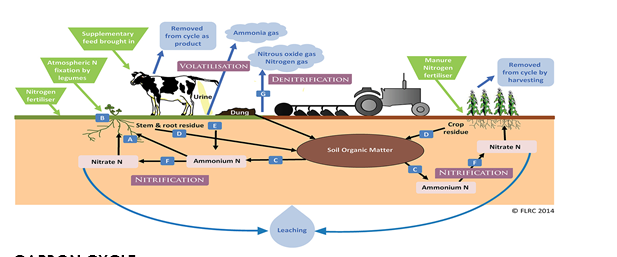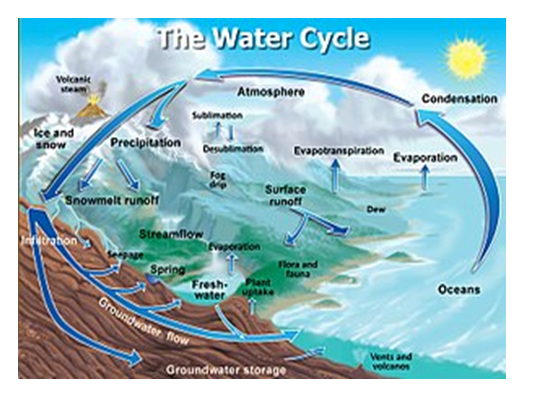Back to: AGRICULTURAL SCIENCE SS2
Welcome to Class !!
We are eager to have you join us !!
In today’s Agricultural Science class, We will be learning about Plant Nutrients and Nutrient Cycles. We hope you enjoy the class!

NITROGEN CYCLES
Nitrogen cycles refer to the circulation of certain nutrients like nitrogen, carbon and water in nature.
The nitrogen cycle is nature’s way of regulating the amount of Nitrogen in the soil and air
Ways by which Nitrogen is added to the soil in Nitrogen Cycle
- Direct fixation by lightening during rainfall.
- Incorporation into the soil by free-living bacteria or non-symbolic bacteria.
- Nitrogen-fixing bacteria in the root nodules.
- Decomposition of organic matter.
- Application of Nitrogen fertilizer.
- Ammonification
- Nitrification
Soil can gain Nitrogen through the following ways
- Symbiotic Nitrogen Fixation
- Electrical discharge
- Non-symbiotic Nitrogen Fixation
- Ammonification and Nitrification
- Application of organic manure and nitrogen fertilizers
Ways by which nitrogen is lost from the soil are:
- By Denitrification
- Soil erosion
- Leaching
- Soil PH
- Bush burning
- Crop removal
- Volatilization
- Oxidation reaction
- Reduction reaction
Processes that lead to the formation of Nitrate from organic matter in the Nitrogen Cycle
- Putrefaction: Decay of plant and animal remains into similar nitrogenous compounds by microorganisms.
- Amminization: Products from putrefaction reactions converted to simple amino compounds and animal
- Ammonization: Conversion of amino compounds and amines into ammonium compounds
- Nitrification: Oxidation of ammonium compounds into nitrites and Nitrates

CARBON CYCLE
This involves the series of processes which contribute to the circulation of carbon in nature.
Explanation
- Carbon dioxide is removed from the air mainly by photosynthesis
- Carbon is lost in the form of carbonates of calcium and magnesium through leaching and drainage.
The atmosphere gains carbon dioxide through
- Burning of fuel like coal and wood
- The action of volcanoes which releases carbon dioxide
- The respiration of plants and animals
- Death and decay and putrefaction of plants and animals
- Diffusion of carbon dioxide from seas and other bodies of water
IMPORTANCE OF CARBON CYCLE
- Plant use carbon dioxide obtained from the air to manufacture their food during photosynthesis
- Provision of carbon which is the essential building block of all organic matters
- Organic matter which is made from carbon helps to replenish soil nutrients.

WATER CYCLE
This is the continuous movement of water from the atmosphere to the earth and from the earth to the atmosphere.
The atmosphere receives water through
- Evaporation from oceans and land
- Transpiration from plants
- Breathing and respiration by plants and animals
Land receives water through:
- Rainfall and precipitation
- Infiltration and percolation
FORMS IN WHICH WATER EXISTS IN THE SOIL
- Hygroscopic water
- Capillary water
- Gravitational water
Ways of conserving water in the soil
- Stoppage or reduction of water-run-off
- Addition of humus or organic mature
- Removal of weeds to reduce transpiration and water loss
- Mulching
- Cover cropping
- Contour ridging
- Appropriate tillage
- Strip cropping
EVALUATION
- Explain Nitrification.
- List five ways the soil can gain nitrogen.
IMPORTANCE OF WATER TO CROPS
- Water provides the medium for absorption of minerals salts
- It facilitates the transfer of nutrients to other parts of plants
- It is an essential raw material during photosynthesis
- Facilities enzymatic activities occurring in crop plant protoplasm
- It is a constituent of protoplasm
- It has a cooling effect on crops
- It helps to sustain life
- It helps in seed germination
- It helps to maintain plant turgor or turbidity

GENERAL EVALUATION
- List five importance of water to crops.
- List three form which water exists in the soil.
- List three ways by which Nitrogen is lost from the soil.
- What is a macronutrient? List five examples.
- What are micronutrients? List five examples.
READING ASSIGNMENT
Essential Agricultural Science for Senior Secondary Schools by O.A. Iwena, Chapter 18, pages 187 – 201
SECTION B
- (a) Differentiate between macro and micronutrients
(b) List three factors influencing nutrient availability in the soil
- (a) State three function of Nitrogen to plants
(b) State three importance of the organic matter in Agricultural
We have come to the end of this class. We do hope you enjoyed the class?
Should you have any further question, feel free to ask in the comment section below and trust us to respond as soon as possible.
In our next class, we will be learning about Farming Practices. We are very much eager to meet you there.

How do i take a quiz
Can u please explain the Phosphorus cycle